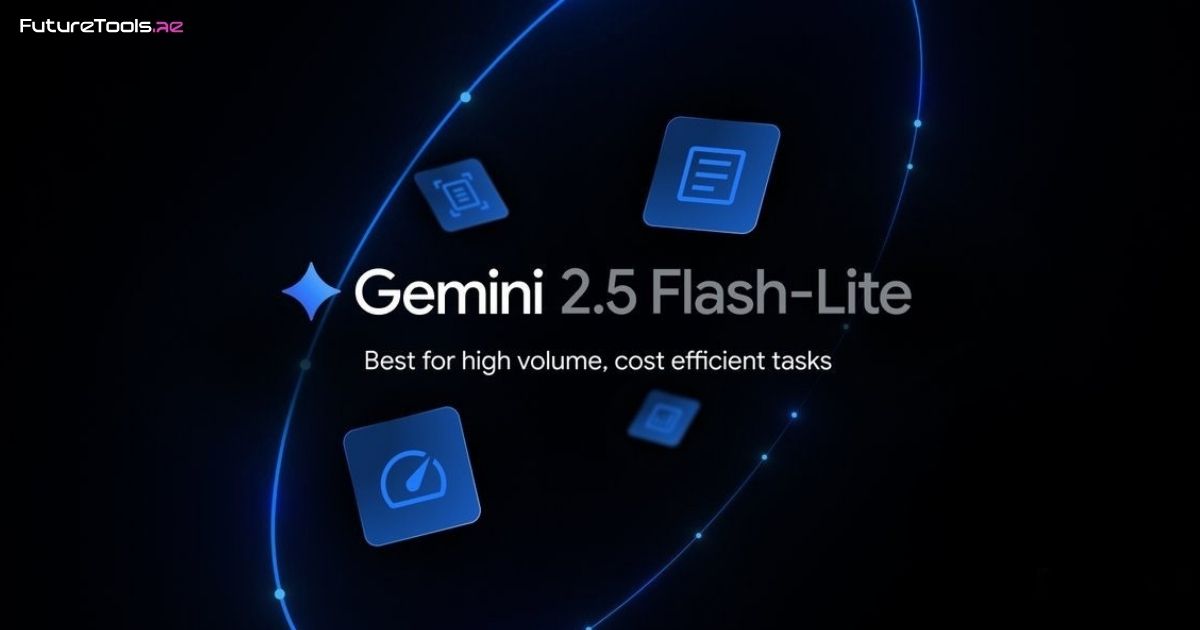Latest AI Tools, Trends & Trusted Reviews!

Google’s latest release, Gemini 2.5 Flash-Lite, has officially dropped, and it’s set to be the workhorse AI model developers have been waiting for. Whether you’re a solo developer working out of a coffee shop or part of a small startup trying to build the next big thing, this AI model is designed to be fast, affordable, and surprisingly intelligent.
And let’s face it—building AI-driven applications is tough. You need something smart enough to handle complex tasks, but you also want to keep your wallet intact. Plus, if your app isn’t quick enough, you’ll lose users faster than a cat chasing a laser pointer. Thankfully, Google has stepped up with a model that’s quick, smart, and won’t have you scrambling for spare change after every API call.
AI development is all about striking the right balance—power without breaking the bank, and speed without sacrificing quality. That’s where Gemini 2.5 Flash temperature comes in.
This model brings lightning-fast performance, far outpacing its predecessors. For those building real-time apps like translation tools or customer service chatbots, it’s a game changer. In the world of AI, every millisecond counts, and with Gemini 2.5 Flash temperature, you can ensure your app responds instantly, keeping users happy and engaged.
Now, here’s where it gets really interesting. The pricing is absurdly good. At $0.10 per million words for input and $0.40 for output, you’ll be able to build and scale applications without having to break the bank. This isn’t just for big players—small teams or even solo developers can get in on the action without needing a budget that looks like the national debt.

You might be thinking, “It’s cheap, it’s fast… but it must be a little bit foolish, right?” Nope, not this time. Google’s Gemini 2.5 Flash-Lite proves that you don’t need to sacrifice intelligence for affordability.
Google insists that this model is smarter than its predecessors, offering improved performance in reasoning, coding, and understanding both images and audio. You’re getting more than just a speed demon; you’re getting an AI that can handle complex tasks with ease.
And for those who want to throw massive data at it—don’t worry. The one million token context window means you can throw entire documents, long codebases, or massive transcripts without causing it to bat an eye. If you’re working with long-winded reports, detailed logs, or anything that requires a bit more mental horsepower, Gemini 2.5 Flash-Lite won’t break a sweat.
So, what’s the catch? There isn’t one. Developers and companies are already using Gemini 2.5 Flash-Lite to solve real-world problems, and their results are impressive. Take Satlyt, a space tech company, for example. They’re using the model to diagnose issues with satellites in orbit. Not only does this save time, but it also helps reduce energy usage—because space missions are expensive, and efficiency is everything when you’re orbiting thousands of miles above Earth.
Another cool use case comes from HeyGen, a company translating videos into over 180 languages using Gemini 2.5 Flash-Lite. For businesses looking to broaden their reach, this could open up a whole new world of possibilities for multilingual content creation and accessibility.
But wait—there’s more. DocsHound is using the model to automatically generate technical documentation by watching product demo videos. Imagine all the hours saved from not having to write those docs by hand! Flash-Lite is handling complex tasks with the ease of a seasoned pro.
Now, if you’re thinking, “Okay, I’m in. How do I get started?” It’s simple. You can start using Gemini 2.5 Flash-Lite right now in Google AI Studio or Vertex AI. Just swap to the new model name “gemini-2.5-flash-lite” before August 25th to avoid any confusion, as Google will retire the old preview version.
No complicated steps. No secret handshakes. Just pick your tools, plug in the model name, and you’re ready to go.
Google’s Gemini 2.5 Flash-Lite isn’t just another model update—it’s a game changer for developers. It’s affordable, smart, and fast enough to make your app feel like it’s got a rocket engine behind it. It removes the barrier of cost, allowing more people to experiment, create, and innovate without needing deep pockets.
Yes, like all AI models, Gemini AI can make mistakes. While it’s highly advanced, it may misinterpret data or generate incorrect responses depending on the context.
No, Gemini AI is not useless. It is designed to perform a variety of tasks like processing text, generating code, and solving complex problems. However, its effectiveness depends on the use case and input quality.
Gemini AI might not have the same level of popularity as other models, possibly due to newer market entry or competition with established tools. However, its affordability and capabilities are making it more recognized.
The default temperature settings for Gemini AI typically range around 0.7. A higher temperature leads to more creative and varied responses, while a lower one makes the output more focused and deterministic.
Yes, Gemini AI can assist in proofreading your documents. It can check grammar, suggest sentence improvements, and provide style recommendations to enhance the clarity and correctness of your writing.
Both Gemini AI and GPT models excel at reviewing files, but it depends on the context. Gemini AI is strong in real-time tasks, while GPT models may be more proficient in generating long-form content and processing nuanced information.
As the world of AI continues to evolve, FutureTools will be your guide through the landscape of cutting-edge tools, trends, and developments. Stay tuned, because with models like Gemini 2.5 Flash-Lite, we’re only scratching the surface of what’s possible in AI. Time to get building!
